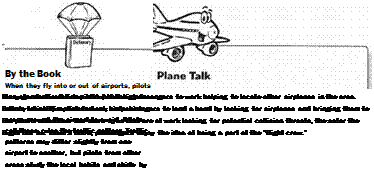Collision Avoidance: Keeping Your Head on a Swivel
In addition to controlling the plane, navigating on course, and communicating with air-traffic controllers, pilots are always on the lookout for airplanes flying nearby. In purely statistical terms, the number of midair collisions is incredibly small, although the risk goes up dramatically near airports, which serve as convergence points for a large number of planes.
Still, it doesn’t take a near collision to get a pilot’s attention. Even airplanes that are just a dot in the distance can loom large as a potential threat. That’s because when airplanes are flying at sometimes hundreds of miles an hour, their head-on speed is so fast that pilots must have very quick reactions to stay out of danger.
Also, when airplanes are speeding through the sky, they lose a lot of maneuverability simply because of inertia. There’s not much that designers can do about that, so pilots must detect possible collision threats early in order to avoid them.
The greatest threat posed by other planes comes from those flying at the same altitude, so pilots spend most of their visual scanning time looking for planes flying at about the same level. They scan systematically, starting from one side of the airplane, moving slowly around the front, and then ending on the other side. The eyes are better able to spot traffic if they scan a small patch of sky for a few moments, then move on to the next patch. A quick sweep of the eyes from one side of the airplane to the other will seldom pick up hard-to-see traffic.
In a typical flight, a pilot, or his passengers, might identify as few as one or two other planes when flying in an unpopulated area, to dozens when flying over large cities. If a pilot spots an airplane, he must determine how far away it is and which direction it is headed. If he decides it won’t be a threat, he should continue to watch it anyway in case it changes course. If the “traffic,” as pilots call other planes, is too close for comfort or seems like it might become a problem in time, the pilot must decide what the best remedy is. In most cases, he’ll turn away from the other plane. In some cases he’ll climb or descend, though this could cause him to become a threat to another flight at a different altitude.
 |
pleasure flight with a pilot cousin and some others from Santa Ana, California, to Catalina Island several years ago, bright sunshine filtering through Southern California smog significantly obscured visibility and forced us to squint into the light One thing we did make out: a Cessna 182 flashing past us in the opposite direction only a few dozen yards away. The combined speeds of the two planes probably approached 300 knots, or345 m. p.h. As I recall, once our hearts stopped pounding we called off the rest of the flight to Catalina and turned back toward the airport eager to be back on the ground where speeding Cessnas are less of a threat
 |
FAA regulations have a good deal to say about how to avoid collision threats. Pilots usually temper those regulations with common sense and a dash of help from airtraffic controllers.













